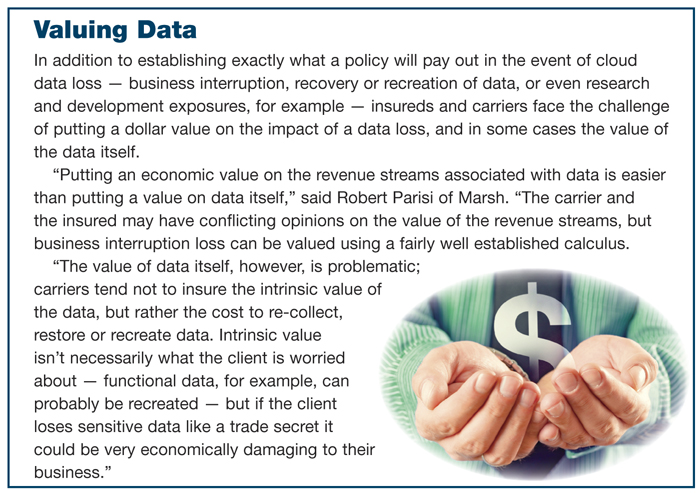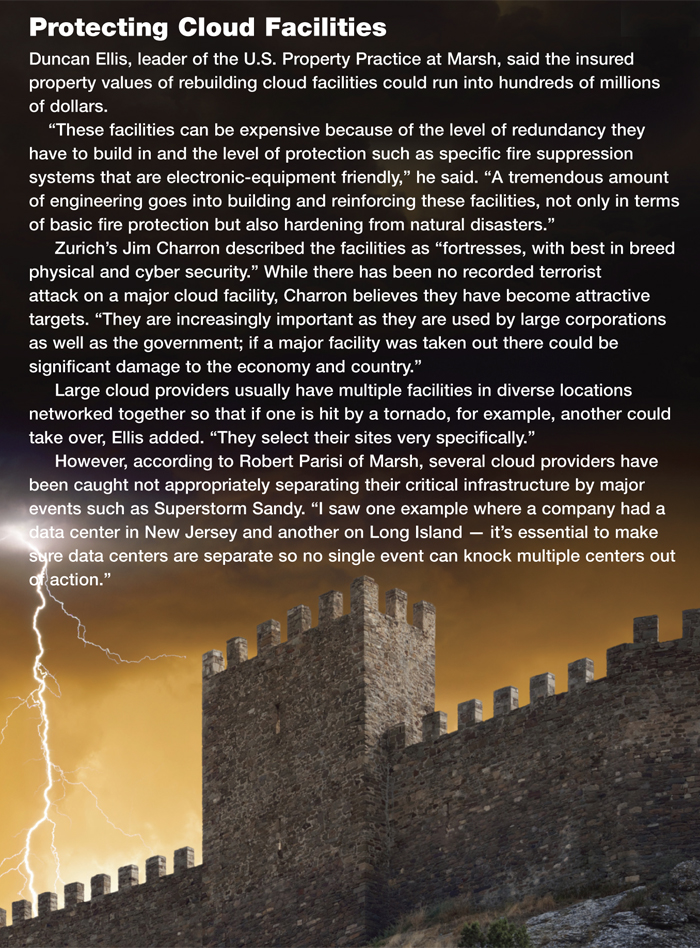Cloud Computing Exposures
The Gap in the Clouds

Cloud computing is integral to modern business. According to market research firm Gartner, the global cloud service industry will be worth $180 billion by 2015, while cloudhypermarket.com estimated a third of all IT expenditures in 2013 would be on cloud computing.
The cloud network is maintained by nearly 35,000 data centers (cloud service facilities containing physical servers), about 25,000 of which are located in the United States. These facilities are extremely well protected, employing the very best physical and cyber security systems, and are usually located in secretive locations away from obvious natural perils.
However, these facilities still require traditional property coverage to insure against risks including flood, fire, storm, earthquake, sabotage, civil commotion and terrorism. If one or more major cloud service facilities were damaged, service could be disrupted and data lost, with far-reaching economic implications for businesses that rely on the service.
Last year, Superstorm Sandy shut down data centers in Manhattan, while Amazon suffered two separate power outages at its Northern Virginia cloud facility forcing many popular websites including Netflix, Instagram and Pinterest offline. But it’s not just media outlets that suffer — thousands of businesses are now actively using the cloud for business purposes, with basic data storage only accounting for 13 percent of cloud usage, according to research firm IDC.
Despite growing reliance on the cloud, Florence Levy, senior vice president and head of Lockton’s Global Technology and Privacy Practice, believes there is a gap in the insurance market that could leave cloud users uninsured for lost data or business interruption in the event of a physical event damaging a cloud facility.
“Traditionally, property policies address physical triggers and harm, while cyber and even errors and omissions policies are intended to address non-physical triggers and economic damage,” she said. “In the event of a physical trigger causing non-physical harm, property underwriters and cyber underwriters will be left pointing fingers at each other.”
According to Jim Charron, Technology Practice leader for Zurich, it is possible to insure data under a property policy, although coverage language often doesn’t capture the entire exposure. “Some [policies] are very clear that they cover computing resources and will specifically state that the coverage includes voice, data and even video, while others are not,” he said. “There are requests for this exposure to be covered and underwriters are responding, but the wording isn’t always reflective of the exposures.”
Charron added that underwriting becomes even more complicated when data is being held by a third-party on behalf of potentially millions of clients.
“Traditional property and business interruption risks already existed for insureds who maintained their computing resources within their own buildings, but with the use of the cloud those risks are subject to equipment not owned by the insured. Once the risk has been transferred to another party the insurance needs to change along with that,” he said. “I think there is an opportunity for insurers to refresh their approach.”
“People are starting to realize this may be a bigger issue than we had previously allotted for in the last couple of years. Savvy clients are asking a lot of questions,” said Levy, adding that brokers are trying to encourage insurers to develop enhanced coverage to ensure cloud users’ data is properly insured.
“The market is trying to figure out a way to address this, whether it is some sort of ‘difference in conditions’ policy that sits above the property and cyber policies, or more collaboration between the property and cyber underwriters and brokers to come up with a more effective solution,” she said.
Levy admitted, however, that creating some kind of hybrid product would be very challenging for insurers. “Cyber and property are two very different coverages with different profitability standards and historical data sets. The most likely solution is an umbrella or difference in conditions policy rather than stretching either set of underwriters beyond their comfort zone,” she said.
Another major challenge is aggregation of risk, with tens of thousands of businesses potentially facing disruption if any of the leading cloud providers went down.
“What is the aggregated business interruption and property damage exposure of one or several of these facilities if they were attacked all at once or there was a large weather event?” asked Charron. “If a major facility is taken down it could have a dramatic impact on the insurance industry.”
“If one cloud provider went down, how many end users would it affect?” pondered Levy. “The danger is yet to be determined, but some carriers are now tracking this information. Once they reach what they perceive to be their maximum aggregate exposure in terms of users using the same cloud provider or number or cloud providers, they may stop providing insurance.”
When in Doubt, Sue
Cloud users may have another form of protection. Robert Parisi, Network Security and Privacy Practice leader at Marsh, who places E&O and professional liability (PL) risks for cloud service providers, believes providers are vulnerable to PL claims, even if interruption or loss of data was caused by a physical risk rather than negligence.
“I don’t think there are gaps in coverage. If a cloud provider is unable to provide their service, it is going to come back at them as a PL claim. The end user is not going to care one whit why the cloud provider wasn’t there when they needed them — they just know they have a contract and the provider didn’t honor it,” he said.
Accordingly, cloud providers have to ensure their E&O and PL policy wordings are airtight in their response to ‘act of God’ type risks or even deliberate physical sabotage and terrorism risks.
“From an end user’s perspective, the principal recovery vehicle is going to be that PL policy, so the cloud providers and their brokers need to look under the hood of their policies,” said Parisi. “The market has evolved and is getting better at providing solutions, and the coverage is fairly broad. It is up to the broker to be aware those solutions exist and stitch them together for [the cloud provider].”
Parisi said PL claims against cloud providers are common, particularly in the litigious United States where cloud users also have very high expectations — anything less than 24-hour service at optimal speed could result in a PL claim, particularly from users whose businesses rely on real-time data feeds, he said.
“Tech companies are regularly sued for failing to provide service or failing to render the service non-negligently. Tech is not perfect, and when it goes wrong, usually the first thing a client of a tech company is going to do is assume the tech provider must have done something wrong,” he said.
“Not only is the cloud provider going to be held to rendering the service and having the service functioning as intended, there is also an element of latency risk; clients want their service working now, on demand, and without any delays.”
In order for the cloud providers to ensure they get adequate coverage against such claims, they must demonstrate high levels of risk management including building redundancies into their systems so that if one facility is damaged, the data can be switched rapidly to another network or facility without being lost.
“One of the large tech companies runs an entirely parallel network right next to their production network so if anything happens they can switch their customers from the day-to-day network to the parallel redundant network in the blink of an eye,” said Parisi.
“That’s an extreme example – most providers don’t have a parallel network. But if they are going to guarantee 100 percent up-time they need to make sure they have the facilities that can do that — and if that means geographically separating their data centers then that is what must be done.”
When it comes to liability for data loss or service downtime, much hinges on the service level agreement between the two parties.
“This agreement defines what level of liability the provider assumes. In that contracting process the provider can say they will deliver their service but there are things outside of their control, and if those things prevent the service the user will have to live with that,” said Parisi. “That won’t always necessarily fly in the negotiation process — in which case the provider may put liquidated damages or limitations of liability clauses with pre-agreed settlements or caps on liability into the contract.”
Parisi added that one of the best things a cloud provider can do to limit their liability is to manage the expectations of the cloud user.
“The quickest way for someone to think the provider did something wrong is for the provider to overpromise,” he said, noting that startup cloud providers are most susceptible to this as they aggressively compete for business.
Ultimately, though, cloud users must take responsibility for their own data — particularly if it is critical to their business. “Cloud users should take it as incumbent upon them as part of their risk management policy to ensure they have their data backed up, and most of them probably do,” said Zurich’s Charron. “The rub is if they are creating new data all the time and there is value in the creation of this new data being generated. Identifying whether data is confidential or mission-critical can help the user understand how often they should back up their data.”
Parisi said cloud use should be treated with the same common sense as any other enterprise risk.
“If you’re relying solely on a third party for the sanctity and security of your data, you are probably making a lot of other mistakes in your business,” he said.













